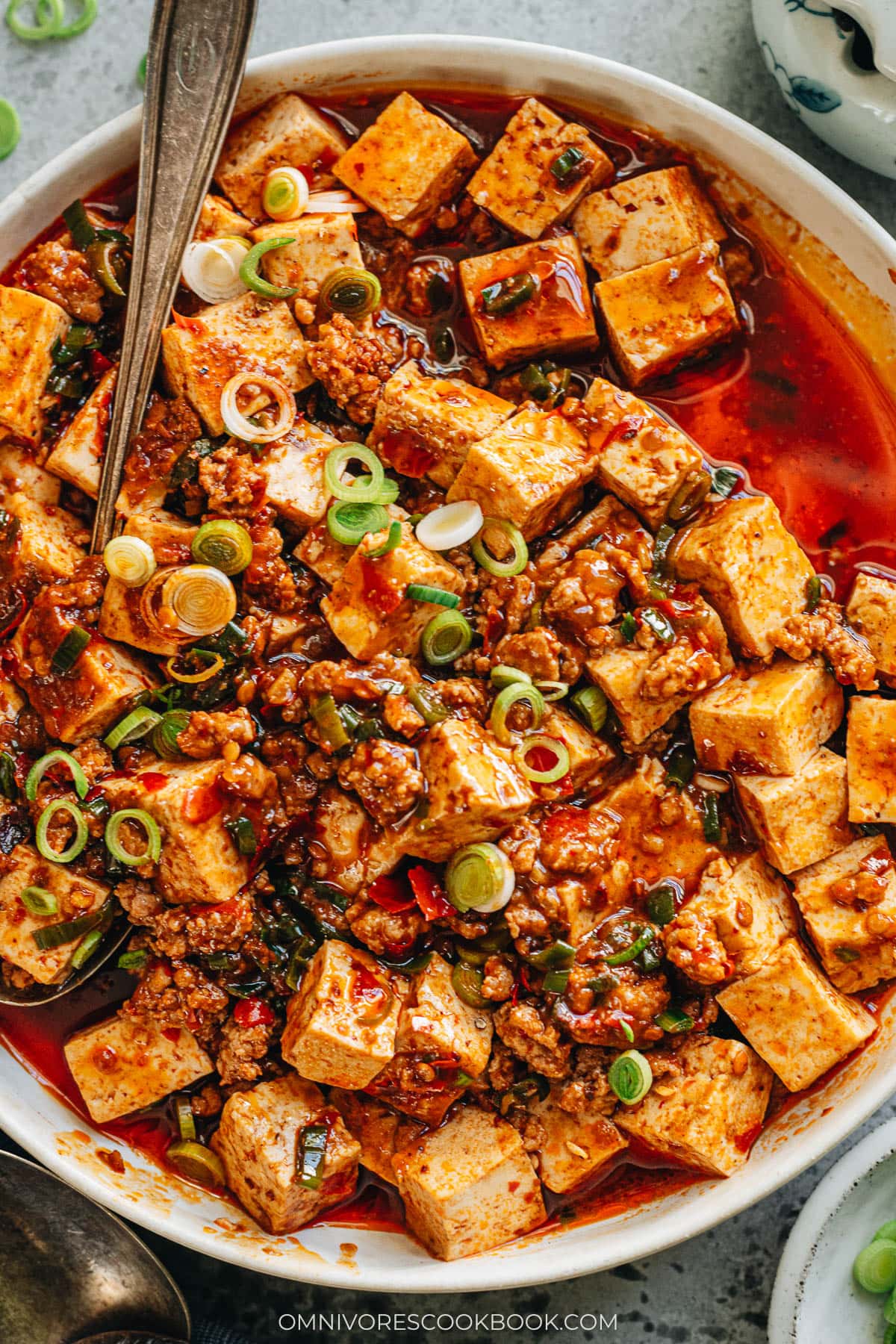
Mapo tofu (麻婆豆腐, ma po dou fu) is one of the most popular dishes from Sichuan cuisine. The tofu pieces are braised in a rich, spicy, savory sauce, along with fresh garlic and scallions. A small amount of ground pork enhances the flavor. The dish is so appetizing, and it goes perfectly with steamed rice.
Cooking mapo tofu is relatively easy, but you need a few special ingredients to get the authentic flavor. I’m sharing my favorite mapo tofu recipe below. It creates the very authentic taste that you’d get at a restaurant in China. However, you can easily tweak the dish according to your preferences.
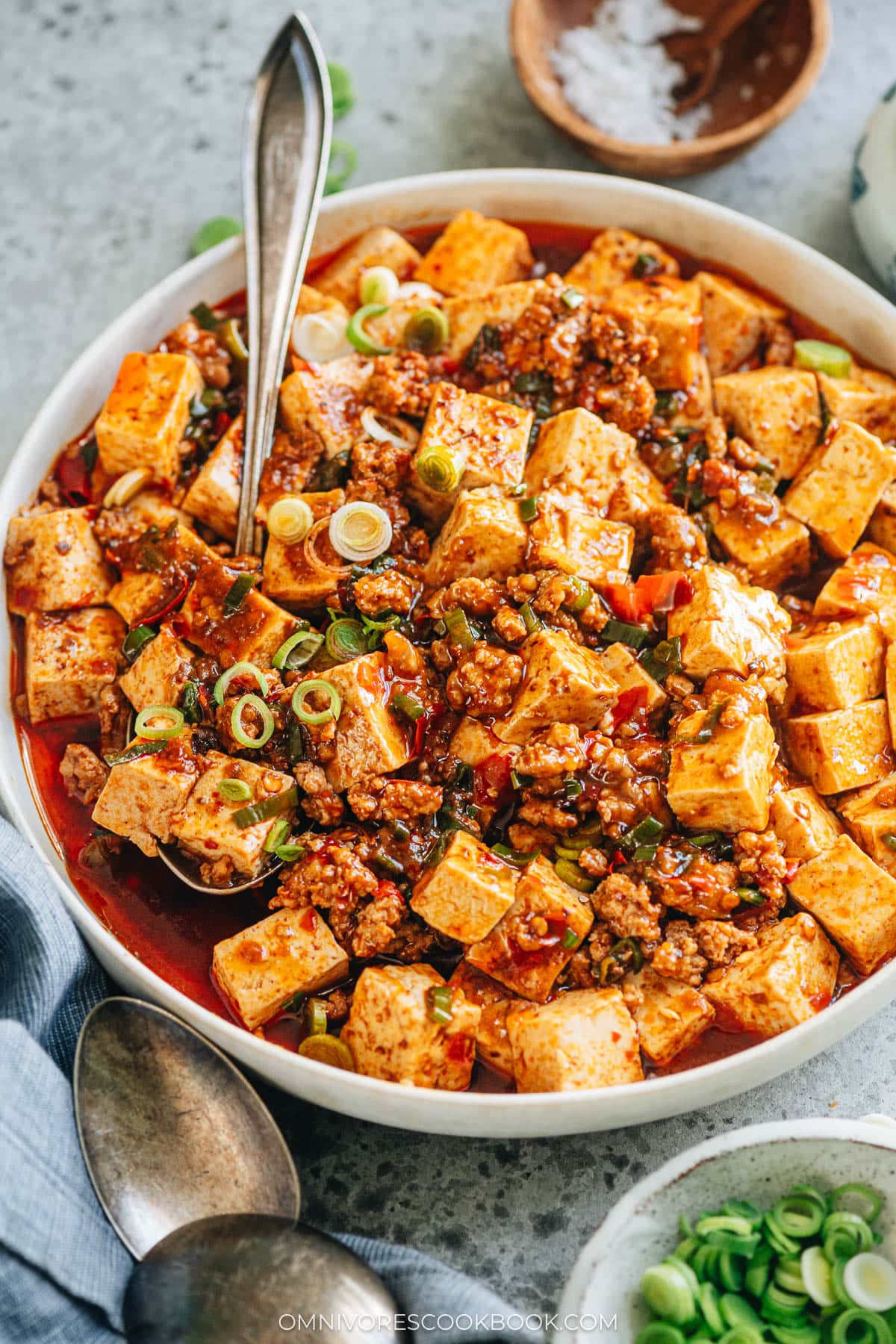
Key ingredients for Mapo Tofu
Doubanjiang
Doubanjiang (豆瓣酱), also known as spicy fermented bean paste, chili bean paste, chili bean sauce, or broad bean sauce, is the most crucial ingredient in mapo tofu. It has a strong, fermented, savory, salty, and spicy taste. Try to find “Pixian Broad Bean Paste” at your Asian market.Pixian is a small county in the Sichuan province that produces the best chili bean paste. If you’re using this brand, you’re already halfway there. You can also purchase this brand on Amazon here.
NOTE: The salt and spice level can vary greatly depending on the Doubanjiang brand. This dish is designed to be served with rice, so it’s on the salty side. To make your dish less salty and spicy, reduce the amount of Doubanjiang to 2 tablespoons.
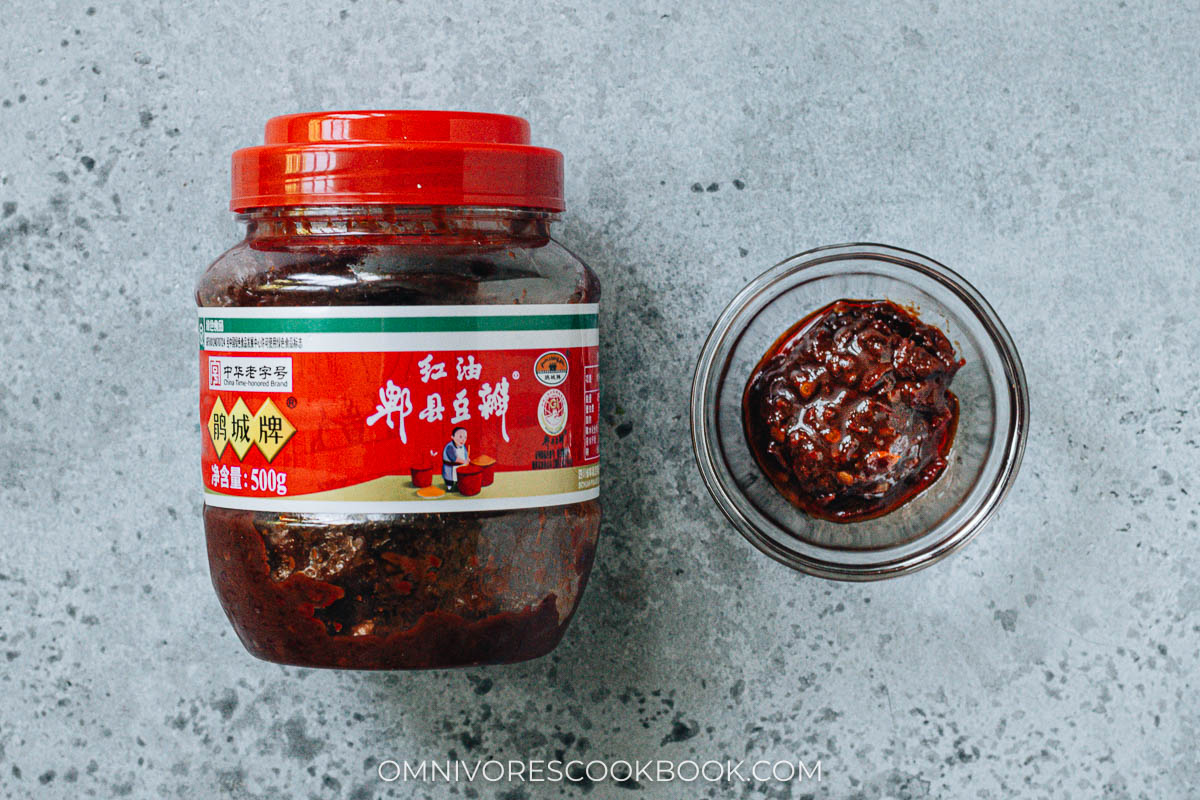
Sichuan peppercorns
Sichuan peppercorn (花椒, hua jiao) is another main ingredient in any Sichuan dish. It has a citrusy taste with a numbing tingling sensation when you chew on it. It’s a crucial and irreplaceable flavor-enhancing ingredient.. You can purchase Sichuan peppercorns at Asian grocery stores, but I highly recommend these premium fresh ones from The Mala Market.
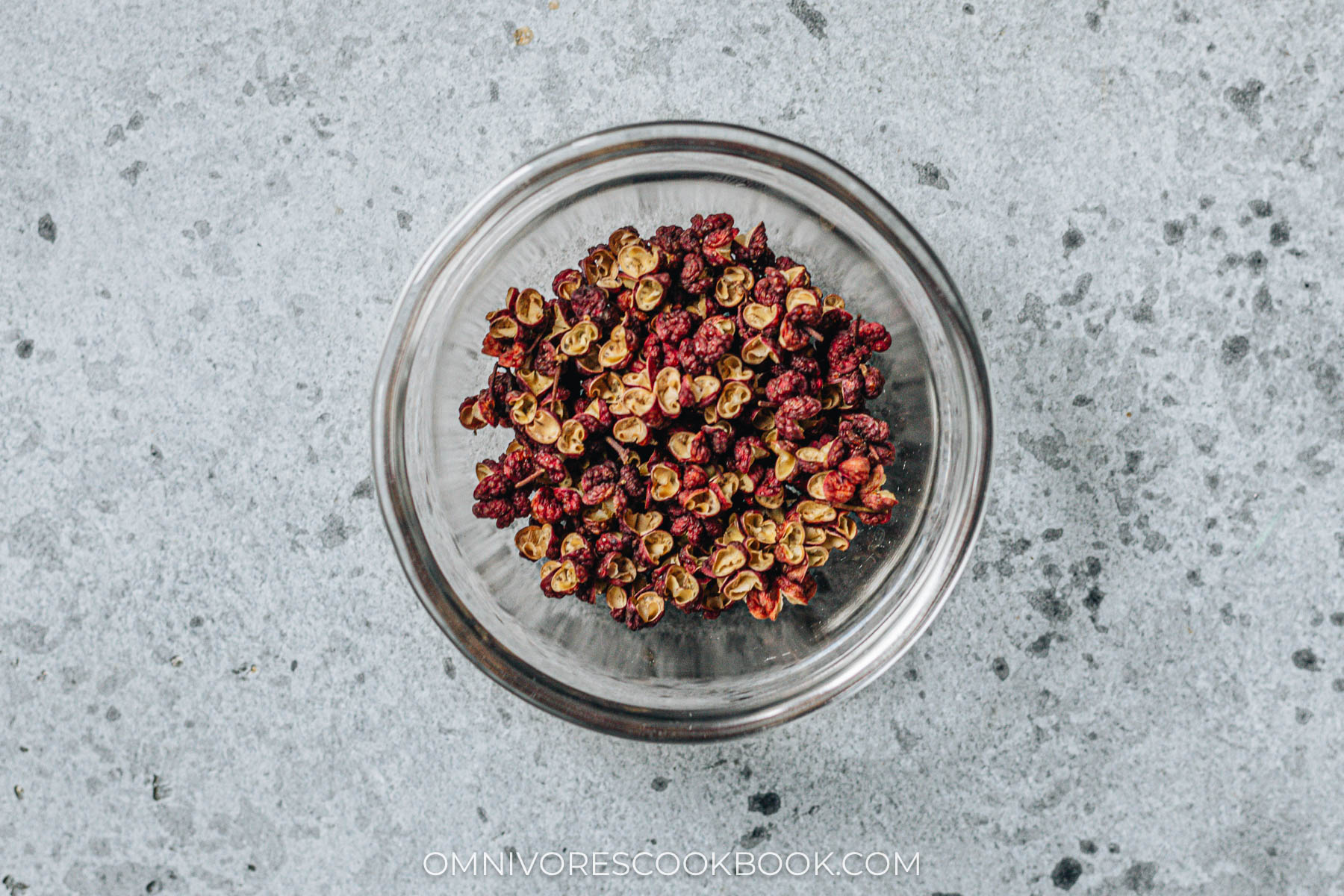
Sichuan peppercorn cooking tips
The most common way to cook Sichuan peppercorns is to fry them in hot oil. Doing so infuses the flavor and makes the dish milder. You can also grind the peppercorns and use them to garnish your dish later.
Alternatively, you can use ground-up fresh Sichuan pepper. I recently got a Sichuan peppercorn grinder from The Mala Market. I love that it’s fast and easy to use. Grind a small amount and add it when cooking or at the end to add flavor. If you have this product on hand, add 1/4 teaspoon ground Sichuan pepper when you add the ground pork.
When you use super fresh Sichuan pepper, the flavor is pungent. You may only need about half of the amount indicated in this recipe. The longer you store the peppercorns, the less fragrance they will have, and the more you need to use.
Homemade chili oil
The other essential ingredient is homemade chili oil (辣椒油). Freshly cooked chili oil tastes much better than store-bought and is free of additives. It only takes a few minutes to cook, and it’s really easy.
If you want to purchase chili oil, make sure to find a high quality one. And it should contains chili flakes and the oil, such as this one.
What to do with leftover chili oil?
You will usually cook more chili oil than you’ll use in one meal. You can store the extra oil in an airtight container in the fridge for 6 months to a year. Use it in various dishes, including Sichuan spicy wonton in red oil and Fu Qi Fei Pian (sliced beef in hot sauce). You can also add it to a dipping sauce for potstickers, to wonton soup to enhance the flavor, or even put it on oatmeal!
It might look like you need so many specialty ingredients for this one dish. But trust me, if you love Sichuan food, you’ll use them repeatedly.
How to cook mapo tofu
Fry the Sichuan peppercorns in the oil to infuse the aroma
- Fry the Sichuan peppercorns in the oil to infuse the aroma.
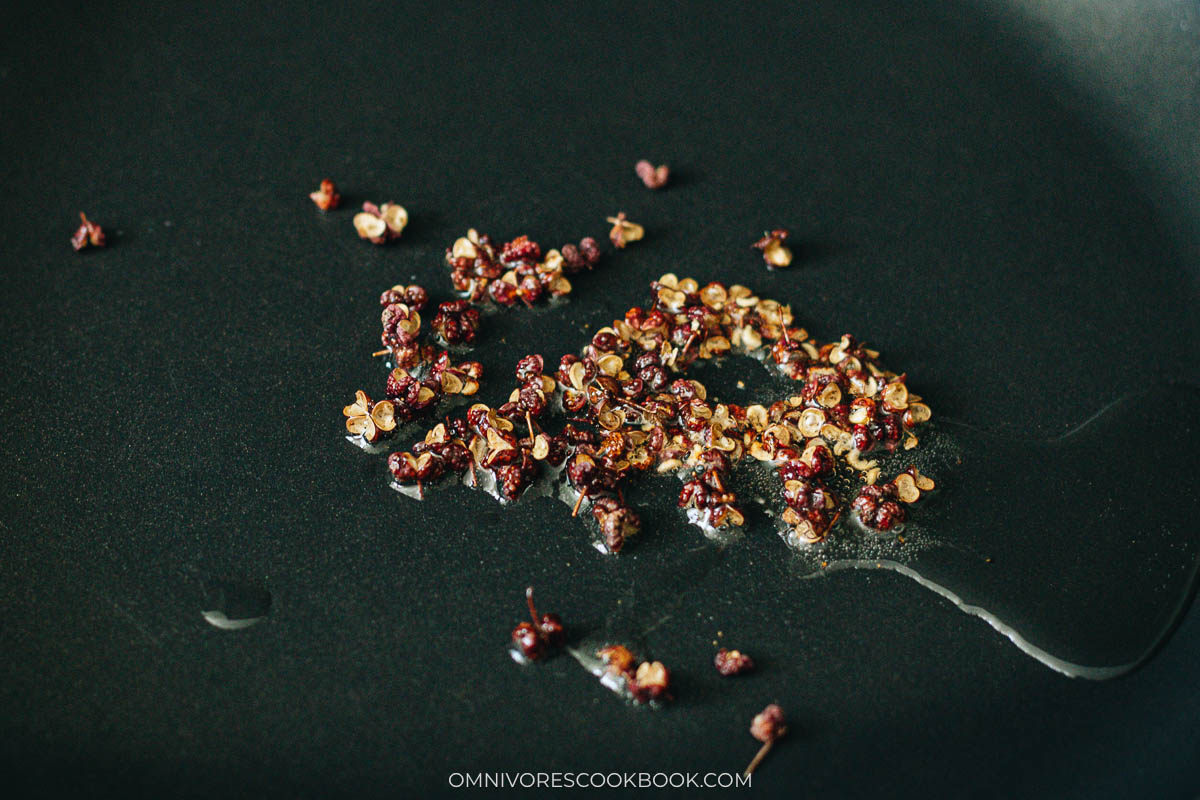
- Cook the ground pork with doubanjiang.
- Once the pork is cooked, add the green onions and stir a few times.
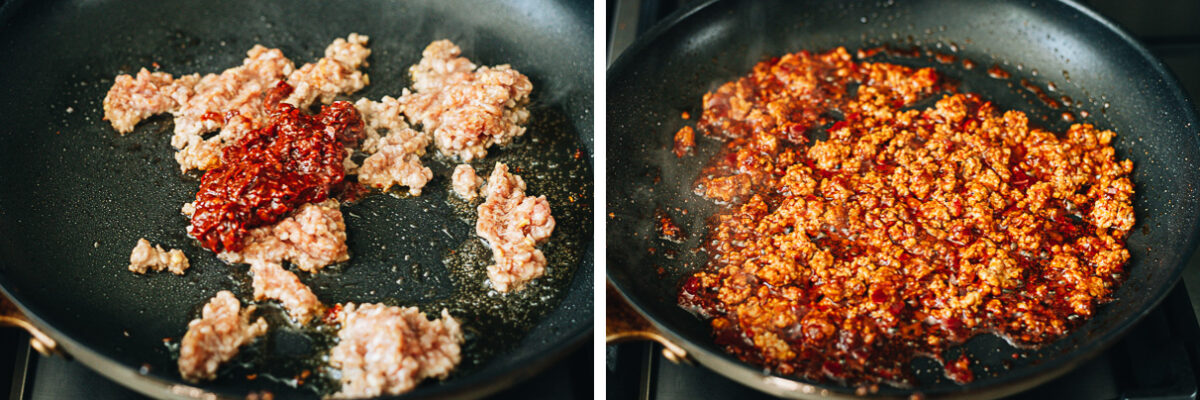
- Add the broth, tofu cubes, and braise with the cover on.
- Drizzle in the cornstarch mixture to thicken the sauce. Sprinkle with scallion greens for garnish.
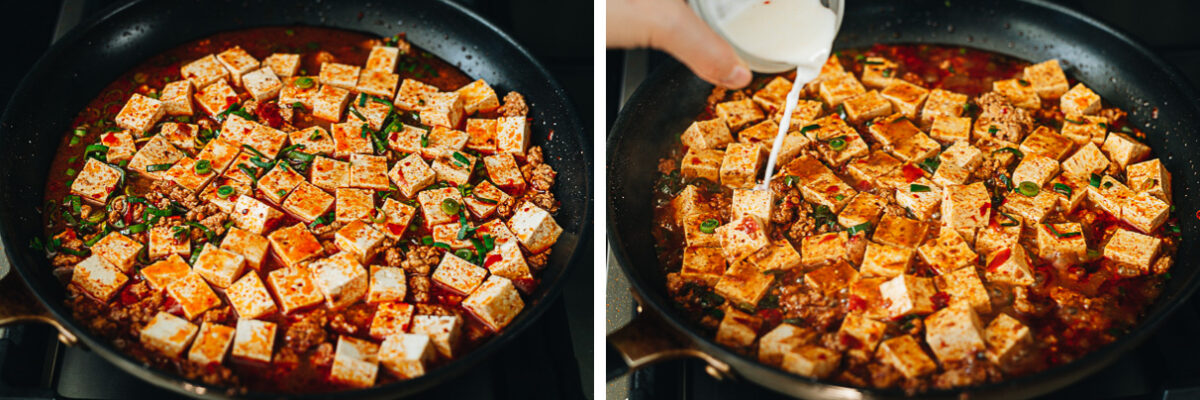
That’s it! I think this is one of the easiest Sichuan recipes, and the result is super rewarding 🙂
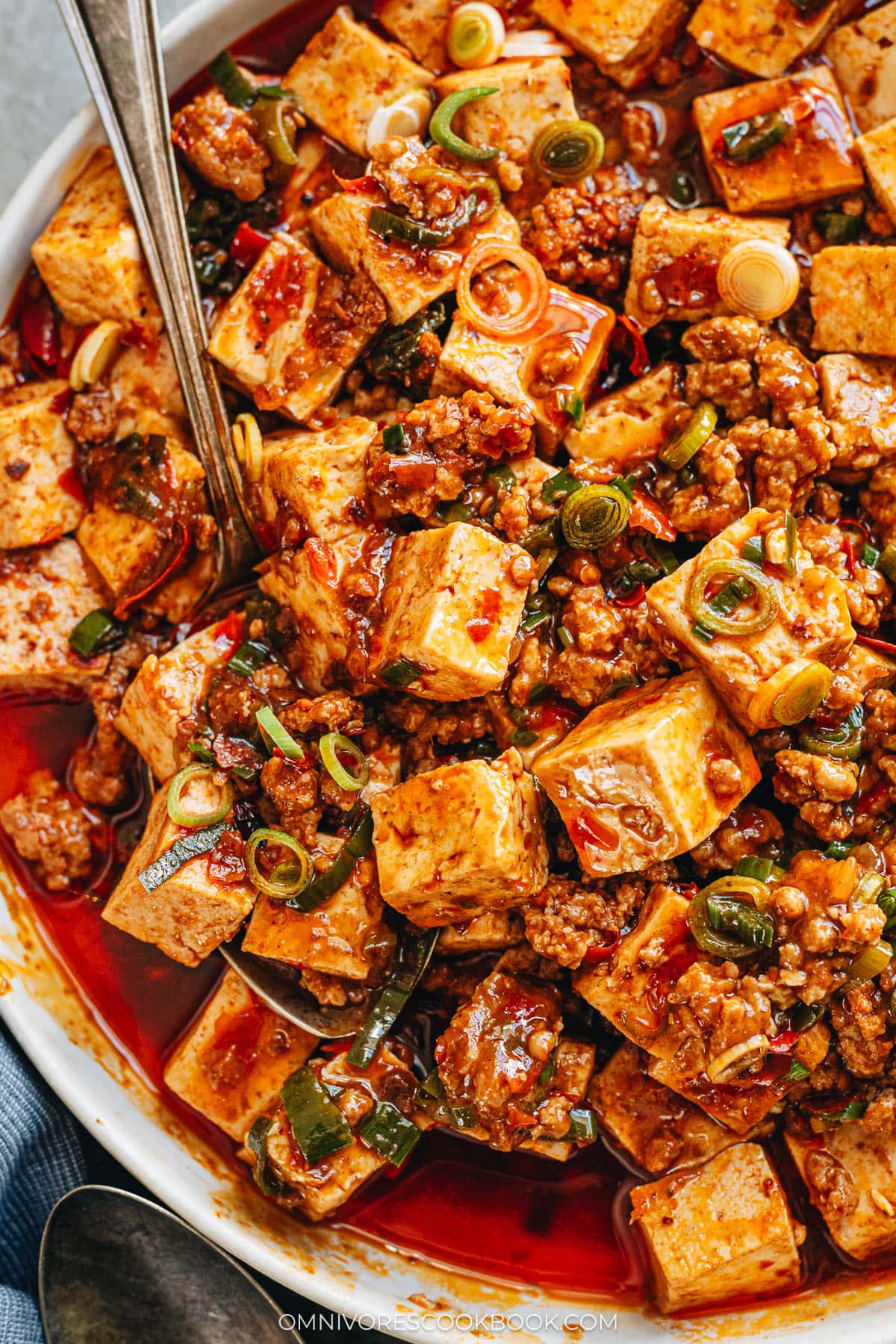
How to serve mapo tofu
I love cooking mapo tofu for a quick lunch or dinner and serving it over steamed rice. Sometimes I double the meat and sauce, so it will be enough to serve two people as a one-dish meal.
I also like to add a handful of greens (spinach, garlic chives, or other tender greens such as chopped up baby bok choy) at the end of braising before adding the cornstarch, to create a more nutritious and balanced meal. Sometimes I also replace the ground pork (used in the authentic version) with ground beef, or ground chicken, depending on what I have in the fridge.
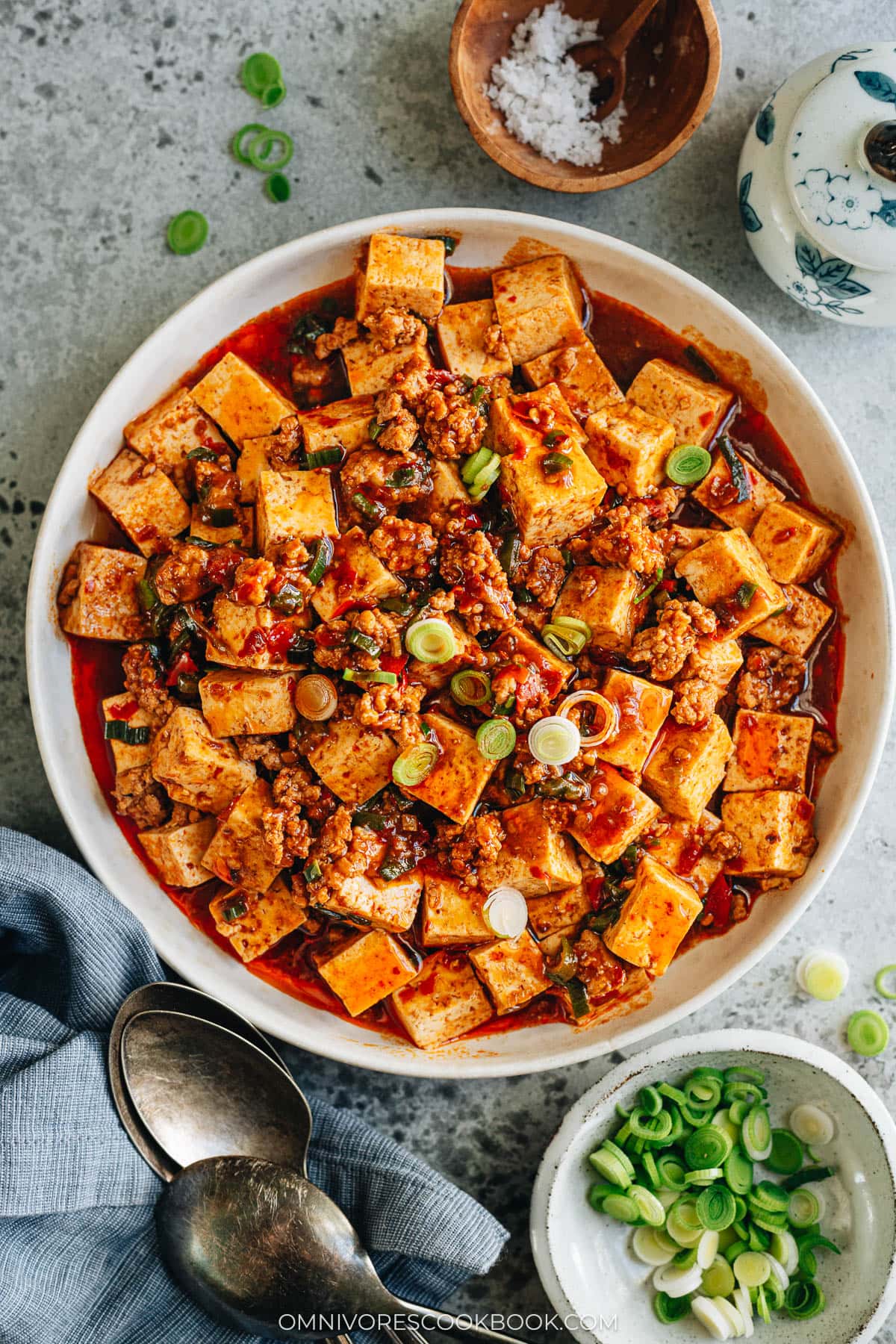
Frequently asked questions
What type of tofu should I use for mapo tofu?
There is no correct answer; you should choose what works best for you. Some Chinese restaurants, including many in China, prefer soft or silken tofu for a melt-in-your-mouth texture. This method requires some experience handling tofu, so you won’t break apart the delicate silken tofu while cutting and cooking.
This dish can also use extra firm, firm, or medium tofu, which is much easier to handle. Plus, once you braise the tofu in the rich, spicy sauce, it absorbs a lot of flavor and tastes great.
Do I need a wok to cook mapo tofu?
Not at all! I found it’s easiest to cook mapo tofu in a nonstick pan. The tofu will sit flat in the broth and absorb all the flavor. Plus, it won’t stick to the pan or fall apart when you stir it.
How do you make mapo tofu vegetarian or vegan?
I have a vegan mapo tofu recipe here that tastes super flavorful!
Chinese Cooking Made Easy
Are you new to this website? This free email series is a great place to start. I’ll walk you through a few of my most popular recipes and show you how and why they work. You’ll quickly start to cook better Chinese food in your own kitchen.
Watch video

Authentic Mapo Tofu (麻婆豆腐)
Ingredients
Marinating
- 4 oz ground pork (or chicken, or turkey) (*Footnote 1)
- 2 teaspoons Shaoxing wine (or dry sherry)
- 1 teaspoon light soy sauce
- 1/2 teaspoon minced ginger
For braising
- 1 teaspoon cornstarch (optional) (*Footnote 2)
- 2 teaspoons Sichuan peppercorns , increase to 3 teaspoons if you like your dish extra numbing, or reduce to 1 teaspoon if your Sichuan peppercorns are extra fresh
- 1 tablespoon peanut oil (or vegetable oil)
- 3 tablespoons Doubanjiang , reduce to 2 tablespoons for a less saltier and less spicy taste
- 2 green onion , chopped
- 1 block firm or medium firm tofu , cut into 1.5cm (1/2 inch) squares
- 1 cup chicken stock (or water)
- 2 teaspoons homemade chili oil (*Footnote 3)
- 1/4 teaspoon five-spice powder
- 1 teaspoon sugar (or to taste)
Instructions
- Combine ground meat, cooking wine, soy sauce, and ginger in a small bowl. Mix well.
- Combine cornstarch with 1 tablespoon of water in a small bowl. Mix well and set aside.
- Heat the oil and Sichuan peppercorns in a large nonstick skillet over medium-high heat. When the Sichuan peppercorns turn dark brown and crispy, scoop them out with a spatula and transfer into a bowl layered with paper towels to soak extra oil. Save to use for garnishing the dish (Optional).
- Add the ground meat and Doubanjiang. Cook over medium heat and chop the ground meat into small bits with a spatula, until pork is evenly coated with Doubanjiang and fully cooked through. Add green onion and stir fry for another minute.
- Spread tofu evenly on top of ground pork (*Footnote 4). Add chili oil, five-spice powder, and sugar. Pour in the broth and cook until brought to a simmer. Simmer, covered, over medium-low heat for 8 to 10 minutes, or until the sauce has reduced to half the original amount. Taste the tofu with some broth (be careful, it will be very hot!). Adjust seasoning by adding salt if needed. If the dish is too spicy, add another teaspoon of sugar to balance it out. Gently mix well with spatula.
- (Optional) Meanwhile, grind the fried Sichuan peppercorns (you used when heating up the oil) in a coffee grinder or using mortar and pestle.
- Mix cornstarch water again until fully dissolved and swirl it into the skillet. Gently stir a few times with a spatula, until sauce thickens. Turn off heat and transfer everything to a bowl.
- Garnish with extra green onion and a small pinch of the ground Sichuan peppercorns, if using (*Footnote 5), if using. Serve hot over steamed rice or by itself as main.
Notes
- You can skip the meat and make this dish vegetarian. In this case, I highly recommend replacing the meat with mushrooms (such as rehydrated dried shiitake mushrooms) to enhance flavor.
- If you like the tofu with more broth, you can braise the tofu for a shorter time and use the cornstarch slurry to thicken the broth. Alternatively, you can uncover and braise until most of the liquid evaporates. The tofu will absorb more flavor this way.
- You can also pour on more chili oil for the restaurant look!
- Do not stir the tofu immediately after adding it into the skillet, in order to keep the pieces from breaking apart. The tofu will get firmer after braising and you can stir it once it’s cooked.
- The Sichuan peppercorns add a numbing nutty aroma to the dish. The fried Sichuan peppercorns have a more rounded body so it works great for garnishing the dish or in a salad. You only need a small amount in this recipe to finish up the dish. Store the rest in an airtight container, no longer than a month.
Nutrition

Did you make this recipe?
I’d love to hear how it turned out for you! Please take a moment to leave a 5-star rating ⭐️ and share your thoughts in the comments further down the page. It really helps others discover the recipe too.

Amber
I truly like your formula and it’s probably one of the most scrumptious Mapo Tofu I’ve at any point eaten. In spite of the fact that there’s an issue when I made it, on the grounds that my brother state it’s salty yet when I attempted it, it’s fine and I’m happy a great many people concurred it’s extremely delectable so I think perhaps it’s prolly social distinction that a few people aren’t utilized to the deadness of sichuan pepper. I followed precisely your formula aside from that I didn’t put salt on it (which is doesn’t bode well why he said it’s salty).
Payton
Could I substitute Lao Gan Ma for the bean paste?
Maggie
I think you can. The flavor of the dish will be slightly different but should be tasty!
James Wood
Your dish was so incredible and delicious. I cooked this dish for my family members. They all were happy to eat this tasty dish and loved your recipe. I will cook this recipe again for my family and friends. Thanks for being sharing this dish with all of us. Happy cooking & Have a great day!
Laura
This recipe is amazing! I always wanted to make my own instead of buying it and this is far superior! A real hit in my house and will be a regular from now on. THANKS !
Erika
I love this recipe and your site in general. I have also made your stuffed aubergine recipe which was delicious. Thanks so much for the great recipes!
Krisztián
I tried this, with every ingredient fresh and homemade. It is wonderful, exactly the type of food i’m always looking for. I actually had to travel to get the Chinese ingredients like doubandjan and shaoxing wine, and sichuan peppercorns, but it definitely worth it. Thank you very much for this recipe. I’ll definitely do this regularly from now on. Maggie you are the best :3 <3
Thomas
Awesome! One of my favorite Mapo Tofu, nice to see your recipe, easy to follow, will cook this for family this weekend. Thanks you!
Steevo
Hi Maggie!
We tried to scale up the recipe 3x to get enough for lunches, but it was inedible because of the saltiness 😭. I believe it was the doubanjiang(I used Pixian), as we used 9 tbsp. The flavor was definitely there, and we’re gonna try it again per the recipe, and knock back the Pixian to 2 tbsp, based on some of the comments. I bet it’s gonna be A-MAY-ZING!
Maggie
I’m sorry to hear the dish didn’t turn out well for you. Doubanjiang is quite tricky because the taste varies a lot depending on the one you buy. Even Pixian has very different brands. Yeah scale down to 2 tablespoons should help.
Carol V. Muse
This was fantastic! I surprised my husband with this recipe today and he was silent (mouth full) for two big helpings lol!
EA
I sub the pork with vegan crumbles and it always works out beautifully.
Suzanne
Maggie – Thanks for providing your recipe for Mopo Dofu. We first encountered it while living in S. Korea and traveled to Shanghai for lunar new year. What luck to find a Sichuan restaurant. We returned several times over a few years and since have not found the same taste anyplace in the US. I took the scenic route and made the chili oil at home, which provided a heavenly aroma. I was in heaven then. The meal met our expectations and I’m just now recovering from a tingly lip. We have no changes to the recipe – it was as good as we remember in Shanghai.
lisa@beef
wow! Delicious! Thank you for such a wonderful and easy recipe!
Peter Crouch
I also like Chinese food a lot, so I’ll try to learn how to make it, which looks pretty easy….
ZAMRIE STORE
My Mom loves to eat tofu so much and your recipes give a lot of cooking way to prepare the healthy meals for her. Thank you so much for your creative and sharing.
Christine
Should the tofu be pressed before it’s added?
Maggie
Hi Christine, you don’t need to press the tofu to cook this dish. The broth is super rich and the cooking time is long enough that the tofu will be flavorful at the end of cooking.
Mattie
My favorite comfort food…God does that look scrumptious! Thank you, now I’m drooling
Devin Sanchez
The first time I saw beef in tofu dish. I want to try it now. They look delicious and easy to make
Lauryn
Very excited to try this recipe!! If I wanted to tone down the spice a notch, which ingredients would you recommend cutting back on?
Maggie
Hi Lauryn, I would cut the doubanjiang. It can make the dish quite spicy and salty depending on the brand you use. Maybe cut it to 2 tablespoons or even less.
Ramirez@habitatrestaurant
Great tofu dish! The ingredients are simple and easy to process, the taste is great. Thanks for your recipe and video tutorials.
Ed Carmichael
I will try this. Thanks for sharing!